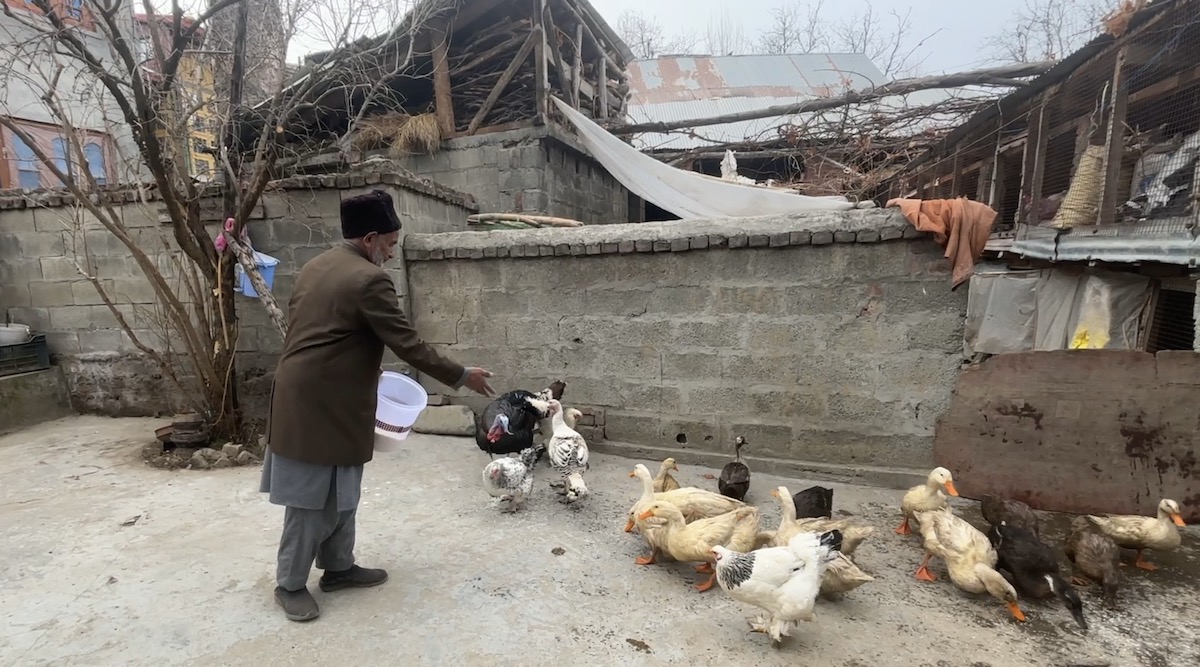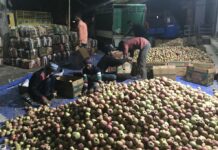Bestowed with impressive foresight, unparalleled intelligence and a never-die sprint, Ghulam Mohammad Mir rose from a day labourer to a model agricultural entrepreneur. At 82, he employs more than a dozen people who run his poultry farm, dairy farm, fish farm and a high-density apple orchard, Iqra Akhoon reports
In the calm landscape of Gadpura, Nowbug, stands Ghulam Mohammad Mir, a resilient farmer whose journey encapsulates the unwavering human spirit and never-say-die approach. Dressed in a cosy checkered blazer paired with a comfortable grey kameez shalwar, his eyes gleam with a blend of curiosity and anticipation, every time, he expects a guest or a buyer.
The life for, Mir, 82, has had a roller coaster ride. Now a wealthy entrepreneur, he is the one who draws inspiration from his past, from his struggle to focus on a battle against poverty. He barely studied up to the third primary and then got into routine farming, the mainstay of the family.
With limited land at his disposal, those were the days when the production was limited and most of the agriculture was about having a rice field and a vegetable garden. There were no cash crops, the way they exist now. So to earn some cash for the family and for his requirements, he would go to Punjab during winter where he would work as a labourer, a practice that was in vogue till the late 1990s. Under the apprenticeship of a Punjab farmer in 1961, Mir learned the intricacies of commercial farming.
A Land Owner!
Mir’s fortunes took a turn in 1971 when his father distributed his meagre landholding among his sons. His share was too small – about 5 kanals of land. Instead of paddy, which was in vogue, Mir chose to cultivate vegetables. He knew the market and vegetables were the only cash crop he thought about. However, he continued to work in Punjab as a labourer during winters.
From day one, he had a clear foresight. He would earn from vegetables and fund his routine around the year. Whatever he would earn as a labourer, he would use it in acquiring small patches of land within and around his village.
Commercial Turmeric
In 1978, Mir got married to a woman of local affluence and toiled tirelessly to provide for his family. His relentless pursuit of prosperity led him to work in Punjab as a labourer during the day and a watchman at night, demonstrating his unwavering dedication to his goals.
It was during that time that he embarked on the unique endeavour of cultivating turmeric on his small piece of land, a practice that had faded out of fashion. This helped him get a distinction for them.
As the news spread, his innovative efforts caught the attention of the then Director of Agriculture, who, impressed by his dedication, gifted him a load carrier. Utilising this gift, Mir began selling vegetables door-to-door, furthering his commitment to his agricultural pursuits. This “progressive nature” added to his vision and reputation.
Soon, he became a ‘call-the-model’ kind of farmer. The agriculture department started facilitating his visits around. One day, when he got a chance to visit SKUAST Shalimar, the main agricultural university in the region, he picked up many things from there. Quickly he got into implementing some of the best practices that he had acquired knowledge about. It was there that he got to know about the concept of integrated farming techniques.

A Poultry Farm
Mir prioritised the establishment of a poultry farm when transitioning to integrated farming. Securing a loan from a bank, he meticulously set up the farm in Pulwama. It worked successfully for many years. Right now, however, the farm is devoid of chickens, which explains the crisis the poultry farmers in Kashmir are facing.
Poultry from Punjab, Mir said dominates the market in Kashmir due to their cheapness. Kashmir growers, he said, have huge input costs and the price of the poultry is being decided by the Punjab suppliers.
“From one-day-old chick to the poultry feed, we are solely dependent on Punjab,” Mir said. “That is why we cannot compete. We required too much money to keep the heating facilities during winters, unlike Punjab.” Besides, the native poultry farmers are hugely dependent on the market retail chain and the fact remains that the farmer ends up earning less than the retailer.
Nonetheless, Mir expressed optimism about resuming poultry farming operations this summer. It’s noteworthy that alongside his other ventures, Mir also keeps turkeys and rabbits on his home farm.
Fish Farm
Mir owns a fish farm as well. However, it has more to do with his understanding of the space than with the fish as commerce.
The village Mir lives in is a spring-abundant place. Most of his patches of land would remain wet through the year. One day, he decided to have a lane so that the extra wetness came out and once he dug almost two feet, the groundwater started coming out.
An intelligent Mir directed the water to a space in a corner and it became a pond.
He introduced fry-lings into the water, nurturing them to grow into fishes. Presently, the fish farm thrives, with a dedicated caretaker ensuring its well-being. Mir allocates 30 per cent of the total income generated from the fish farm to the caretaker, a woman entrusted with its maintenance. The marketing model is much better than the honchos of corporate will ever think, It has more to do with informal shareholding than with the profit-sharing.
The Vegetables Gardens
Mir has more than 30 kanals of land now. Most of it he acquired after investing the money he earned as a labourer. His focus is on inter-cropping. However, he has a vast vegetable garden that grows vegetables which are uncommon in Kashmir.
Mir’s garden grows broccoli, lettuce, banana, collard greens, purple cabbage, onions, garlic, turmeric and many other things. Some of these vegetables are too costly for local consumption and are sold in certain elite Srinagar localities.
Apple Orchards
Right now, the high-density apple is in fashion. Credit goes to Mir he has already a sort of high-density apple orchard. Most of his orchard has hybrid apple trees which are drip-irrigated and have iron rails for support.
“These trees originate from Austria and belong to the M9 variety, and are meticulously irrigated through drip systems,” Mir said. Right now, he harvests two boxes of apples from every tree, every season.
A Cow Farm
In his cattle shed, Mir keeps around eight to nine high-breed cows, each of varying breeds. Collectively, he said, these cows produce 12 to 15 litres of milk per day per cow. He has employed many workers to attend to their care.
Mir is a satisfied ‘young’ man. He works on his farm and wants his story should somehow get replicated by the next generation. He has ensured that everybody at his home picks up a skill.
Mir admitted he leads a contented life with his two employed sons and four married daughters. His daughters-in-law, who actively participate in farming alongside him, have been honoured by the government for their significant contributions to the field. Mir himself has been recognised with 20 awards to date for his outstanding achievements and has received numerous awards for his contributions to agriculture. He opens his farm to students, inspiring the next generation to embrace sustainable practices.
Employing twelve individuals and providing them with quarters, Mir fosters a sense of community while ensuring fair compensation for his workers. To facilitate their work and ensure their well-being, Mir has constructed quarters on the same land, eliminating the need for them to pay rent. He ensures they receive a minimum monthly salary Rs 12,000.
Mir has undertaken the pilgrimage to Makkah twice, accompanied by his wife, and has also travelled extensively across various destinations in India.















